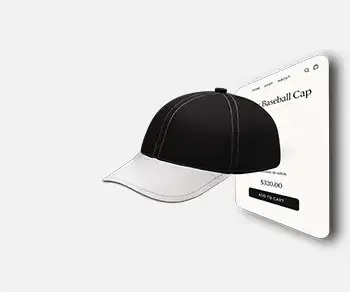Better Product Understanding with 3D Ecommerce
Today's competition is fierce, and brands need a competitive edge
3D ecommerce elevates the perceived value of products, creates a memorable brand identity, and helps customers see your products with complete accuracy.
No plugins required
Works on all devices
Native web component
Compatible with all eCommerce CMS platforms
3D for ecommerce and product pages is a native web component that allows for product rendering directly in browsers without plugins.
This native support makes it much easier for ecommerce platforms to implement 3D product visualization with better performance and without requiring customers to download additional software.
The 3D Ecommerce Advantage
Brands with interactive 3D experiences immediately distinguish themselves from competitor.
Forge a powerful connection between your brand and cutting-edge shopping experiences through our 3D configurators.
Unlike static images, our interactive technology demonstrates product features dynamically, communicating your brand values through engagement rather than simple description.
Our solution integrates seamlessly onto your Product Detail Pages without complex implementation. This direct integration enhances your product presentation with interactive elements that showcase your items in their best light.
The 3D experience follows your customers from Product Listing Pages to Product Detail Pages. It preserves all customization choices as shoppers navigate through your site. This continuous interactive experience not only increases engagement but also maintains the personalized connection customers have established with your product, significantly improving conversion rates.
- Enhanced product visualization that drives customer engagement
- Customization capabilities that increase conversion rates
- Interactive functionality demos that reduce return rates and build consumer confidence
High Compatibility with E-commerce Platforms
CMS Ecommerce integration
Our 3D asset management tools are designed to create 3D configurators or 3D viewers that can be integrated into ecommerce product pages. Regardless of your ecommerce CMS, integration with your ecommerce platform is easy and intuitive. All major e-commerce CMS platforms fully support our 3D configurators and viewers.
- Cloud hosting
- Access to your data at any time.
- Products lifecycle and version management
- Domain-name whitelist




Compatible with major CMS platforms including Adobe Experience Manager, Contentful, Sitecore, and custom-built content management solutions.
Embedding your configurator is easy, regardless of the eCommerce CMS you use. Just copy and paste a simple javascript tag into your site's HTML code to add your configurator or 3D visualizer.
- Easy integration
- Without any plugin
- Native HTML 5
- Without blocking SEO
- Fast 3D loading optimized for ecommerce
- E-commerce friendly
- Worldwide replicated servers
- Domain protection
- GraphQL API
Our 3D asset management provides tools to manage your 3D products
Once you log into our digital asset management for 3d models, you'll have access to all the tools you need to manage your 3D projects throughout its entire life cycle.

With our Seamless 3D Integration, your ecosystem is our priority
Product 3D viewer Optimized for Worldwide E-commerce
To meet the demands of e-commerce, our infrastructure is optimized for fast loading of 3D Products. Our worldwide replicated servers guarantee the availability and stability of your 3D configurators.
No impact on SEO
Loading your 3D products has no negative impact on your SEO. Our solution ensures that the 3D viewer script is not executed until the HTML document is fully parsed.
Security
A Highly Secure Solution
The 3D configurator embedded on your website does not track end-user activity. It only tracks minimal website information for billing purposes.
- A domain-name whitelist ensures that your configurators are not used on malicious websites
- Two-factor authentication (2FA) available for all users
- Fine-grained authorization can be set up for any user
- Audit logs available in real time
- All assets are encrypted at rest with AES-256
- All emails sent are secured with DKIM, SPF and DMARC to prevent spoofing
- Our back-office is regularly scanned for security issues and is scored A+ on Mozilla Observatory
- Connections to our platform are enforced through SSL using HSTS
Explore next

Fred
We elevated Fred's e-commerce with a 3D configurator and AR virtual try-on for their iconic bracelet, driving conversions and brand innovation.
